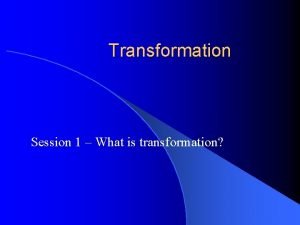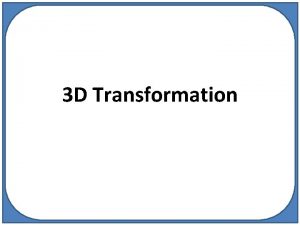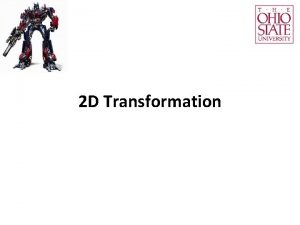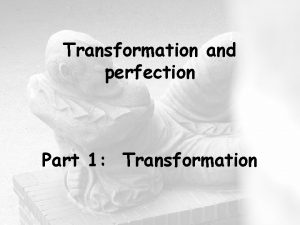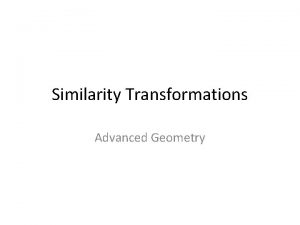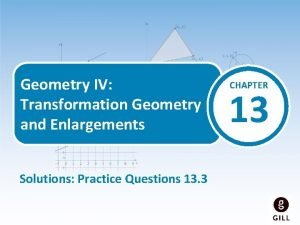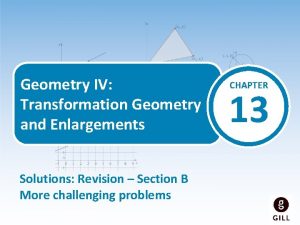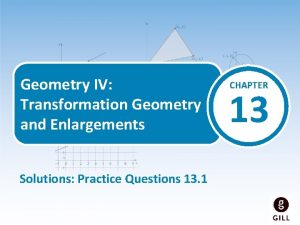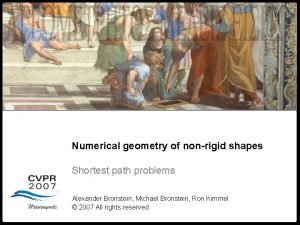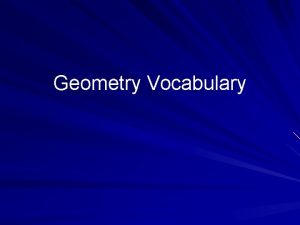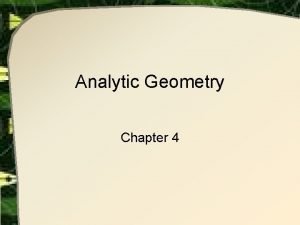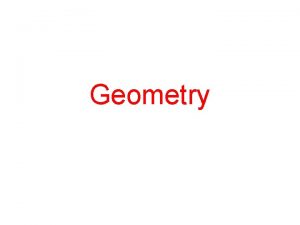Transformation Geometry For Students Transformation Geometry n n




















- Slides: 20

Transformation Geometry For Students

Transformation Geometry n n Transformation geometry is the study of figures that move under certain conditions. In other words it is the study of moving a shape from one position to another

Transformations n There are two categories of Transformation Geometry, these are: n n Isometries Similarities n Isometries, the shape &size of the object do not change n Similarities the shape of the object is retained but the size changes OBJECT before transformation IMAGE after transformation

Isometries n This category is broken into four different transformations, these are: n n Translation Axial symmetry Central symmetry Rotation

Similarities n This category is broken up into two different categories, these are: n n Enlargements Reductions

Translations n Under a translation all points of an image are moved the same distance in the same direction n Relate translation to an object on a conveyor belt. On a conveyor belt all objects move the same direction, the same distance apart and in the same manner.

Translation n Every translation has a translation vector, this tells us the distance and the direction in which the object is moved

Axial symmetry n Under axial symmetry, any point and its image are mirrored the same distance away from a plane as it is to the plane. n axial symmetry can be related to a mirror image of an object, we see everything in reverse. Also a reflection of the object is the same distance form the mirror as the image appears to be from the mirror

Axis of Reflection n Axis of Reflection—this is the line of axis that the object is flipped over to become the image. The rule is that the object is projected perpendicular through this line

Rules of Axial Symmetry n With axial symmetry we see that: n n An object and its image are congruent (equidistant) The position of a point on the axis of reflection stays in the same position The axis of reflection, being the locus of all points equidistant from a point and its image, is the perpendicular bisector of a line segment joining a point and its image. A point and its image are equidistant from the axis of reflection

Central Symmetry n Central symmetry is the reflection of an object through a point and on the same distance at the other side.

Centre of Symmetry n n This is where the points of the object are projected through and out equidistant on the other side. In central symmetry the image is always upside down and back to front compared to the object.

Rotation n Under a rotation, a figure is: n n Turned about a fixed point Through a certain angle The fixed point in which the object is rotated is called the centre of rotation The angle in which it is turned about is called the angle of rotation.

Enlargements n n n Under an enlargement an object is projected onto a similar object and a parallel line. Centre of enlargement—is the point from where the enlargement measuring from. Scale factor—The length of the enlargement, this is given in a ratio to the length of the original.

Reduction n Reduction is the exact same as enlargement except the opposite way around!!! n centre of reduction

Axial symmetry—Rotation n A combination of two axial symmetries is a rotation.

Axial symmetry—Central symmetry n A composition of two axial symmetries in a perpendicular axes is a central symmetry

Central symmetry--Translation n A composition of two central symmetries is a translation

Theorems in Transformation Geometry n n n Parallel projection conserves equality and proportion of length. Translation maps a line onto a parallel line. Central symmetry maps a line onto a parallel line. The composition of two central symmetries (point reflections) is equivalent to a translation. The composition of two axial symmetries (line reflections), in intersecting axes, is equivalent to a rotation. The composition of two axial symmetries in perpendicular axes is a central symmetry in their point of intersection. The composition of two axial symmetries in parallel axes is a translation. An enlargement maps a line onto a parallel line. Axial symmetry, central symmetry, translations and their composite mappings are isometries (conserving measure of length, angle and area). The composition of translations is both commutative and associative. The composition of reflections is neither commutative nor associative.

TERMINOLOGY n n n n n n ANTICLOCKWISE: Rotating to the left as you look at the page. AXIAL SYMMETRY: To flip an object over a line. BISECT: To bisect something means to cut it into two equal halves. CENTRAL SYMMETRY: Reflection of an object through a point. CLOCKWISE: Rotating to the right as you look at the page. CONGRUENT: Congruent means equal in all respects. ENLARGEMENT: To make an object bigger. INTERSECTION: Where the two lines cross/meet. IMAGE: Outcome of the object after it ahs been transformed ISOMETRY Object moves under a transformation but the size doesn’t LINE SEGMENT: A line segment begins and ends at particular points OBJECT: Original figure before it is moved under its transformation PARALLEL LINES: Lines that never meet. They run side by side PERPENDICULAR LINES: Lines that meet at a right angle (90º). PLANE: A plane is a flat surface that extends in all directions. REDUCTION: To make an object smaller RIGHT ANGLE: A right angle measures 90°. ROTATION: To turn an object around a fixed point. SIMILARITY: The size of the object changes but the shape stays the same. THEOREM: A theorem is a proven mathematical statement. TRANSLATION: To move an object means by sliding it without rotating it. TRANSFORMATION GEOMETRY: The study of figures that move under certain conditions.
 The first favorite novel of rizal
The first favorite novel of rizal Relativ standardavvikelse formel
Relativ standardavvikelse formel Datorkunskap för nybörjare
Datorkunskap för nybörjare Tack för att ni har lyssnat
Tack för att ni har lyssnat Treserva lathund
Treserva lathund Returpilarna
Returpilarna Läkarutlåtande för livränta
Läkarutlåtande för livränta Påbyggnader för flakfordon
Påbyggnader för flakfordon Tack för att ni lyssnade
Tack för att ni lyssnade Tobinskatten för och nackdelar
Tobinskatten för och nackdelar Egg för emanuel
Egg för emanuel Tack för att ni har lyssnat
Tack för att ni har lyssnat Tidbok
Tidbok Rutin för avvikelsehantering
Rutin för avvikelsehantering Var finns arvsanlagen
Var finns arvsanlagen Verifikationsplan
Verifikationsplan Rbk mätning
Rbk mätning Kontinuitetshantering i praktiken
Kontinuitetshantering i praktiken Myndigheten för delaktighet
Myndigheten för delaktighet Presentera för publik crossboss
Presentera för publik crossboss Var 1721 för stormaktssverige
Var 1721 för stormaktssverige























